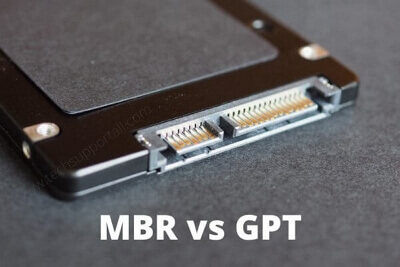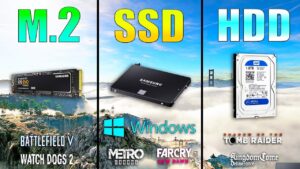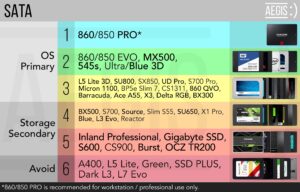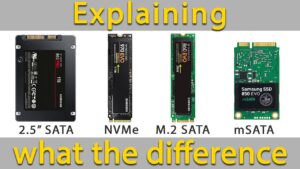Mbr Vs Gpt Nvme Ssd : Which is better!
When choosing between MBR and GPT for your NVMe SSD, GPT is the preferred option. GPT (GUID Partition Table) provides more robust error handling, supports larger partitions (over 2TB), and allows for a higher number of primary partitions than MBR (Master Boot Record).
MBR and GPT are partition structures used to manage the physical sectors of your storage devices such as NVMe SSDs. MBR, an older standard, only supports partitions up to 2TB and is limited to 4 primary partitions.
On the other hand, GPT, a more modern standard, supports partitions larger than 2TB and allows for virtually unlimited primary partitions, making it more suitable for modern, high-capacity NVMe SSDs.
While both MBR and GPT can be used for your NVMe SSD, GPT’s advantages in terms of error handling, partition size, and the number of partitions make it the better choice for modern storage devices.
It’s particularly beneficial for NVMe SSDs with a capacity larger than 2TB. Migrating from MBR to GPT can also be done without data loss, further easing the transition.
7 Comparison: MBR vs GPT for NVMe SSDs
| Feature | MBR NVMe SSD | GPT NVMe SSD |
|---|---|---|
| Partition Size Limit | 2TB | More than 2TB (up to 9.4 ZB) |
| Partition Numbers | Maximum 4 partitions | No partition limit |
| Boot Mode | BIOS | UEFI |
| Redundancy | No redundancy. If the MBR is corrupted, the data is lost | Contains a copy of primary GPT, providing a higher level of disk and data protection |
| Compatibility | Compatible with all systems | Compatible with newer systems |
| Use Case | Typically used on disks smaller than 2TB | Used on disks larger than 2TB, or when more than 4 partitions are required |
| File Systems | FAT32, NTFS, etc. | NTFS, FAT32, and also supports other modern file systems like ext4, exFAT, etc. |
Key Takeaway

Five Facts About: 7 Comparison: MBR vs GPT for NVMe SSDs
What Is Mbr?
MBR and GPT are two different disk partitioning styles, but when it comes to NVMe SSDs, GPT is the recommended choice.
GPT supports larger capacities and offers better performance compared to MBR. Additionally, GPT is more reliable and compatible with modern operating systems.
Brief Explanation Of Mbr (Master Boot Record):
The MBR, short for Master Boot Record, is a crucial component of computer systems that facilitates the booting process.
It resides at the very beginning of the hard drive and contains vital information about the partitions and file systems on the disk.
Here are some key details about MBR:
- MBR is a small chunk of data (approximately 512 bytes) that serves as the first sector of a storage device, be it a hard disk drive (HDD) or a solid-state drive (SSD).
- Its primary function is to act as a roadmap for the system to find the active partition on the drive and load the necessary boot loader.
MBR consists of three primary elements: The boot code, partition table, and disk signature.
- The boot code, also known as the master boot code (MBC), is responsible for launching the system’s boot loader program.
- The partition table holds information about the primary and extended partitions present on the disk. It contains details like the starting and ending locations of each partition and the file system associated with it.
- The disk signature provides a unique identifier for the disk, aiding in distinguishing it from other storage devices connected to the system.
- The MBR’s limitation lies in its reliance on the Legacy BIOS firmware, which restricts disk capacity to a maximum of 2 terabytes and limits the number of partitions to four primary partitions or three primary partitions and one extended partition.
Historical Context And Its Limitations:
To better understand the significance of MBR, it is essential to consider its historical context and acknowledge its limitations:
- MBR was developed in the early days of computing when storage devices were primarily HDDs and BIOS was the prevalent firmware.
- With the increasing popularity of SSDs and the emergence of the Unified Extensible Firmware Interface (UEFI), MBR faced challenges due to its legacy design.
- The primary limitations of MBR include its restriction on disk capacity, limited partition support, and vulnerability to various forms of malware.
- MBR struggles to handle modern storage technologies, such as NVMe SSDs, which offer significantly faster speeds and increased storage capacity.
Significance In Relation To Nvme Ssds:
Despite its limitations, MBR still holds significance in the context of NVMe SSDs:
- While NVMe SSDs predominantly rely on the more advanced GPT (GUID Partition Table) scheme, MBR can still be used in specific scenarios.
- MBR provides backward compatibility, allowing NVMe drives to work with older systems that lack UEFI support or have compatibility issues.
- Certain operating systems, like Windows, may require MBR for specific functionalities or compatibility with legacy software.
- MBR has a smaller footprint compared to GPT, making it suitable for devices with limited storage space, such as smaller embedded systems.
To summarize, MBR, as a master boot record, has been a fundamental component of computer systems for decades.
Despite its historical context and limitations, it continues to play a role in relation to NVMe SSDs by offering backward compatibility and fulfilling certain software or system requirements.
However, with the advent of GPT and modern storage technologies, MBR’s prominence has diminished in favor of more advanced partitioning schemes.
What Is Gpt?
GPT, or Guid Partition Table, is a type of disk partitioning scheme used with NVMe SSDs. It offers advantages over MBR, such as support for larger disk sizes and more partitions.
If you’re familiar with partitioning your computer’s hard drive, you may have come across the terms MBR and GPT.
In this section, we’ll delve into GPT (GUID Partition Table) and explore its advantages over MBR, as well as its compatibility with NVMe SSDs.
Introduction To Gpt (Guid Partition Table)
The GUID Partition Table (GPT) is a modern partitioning scheme used on UEFI-based systems. It replaces the older Master Boot Record (MBR) partitioning scheme, offering several significant improvements.
Let’s take a closer look at what GPT brings to the table:
Greater Partitioning Capacity:
GPT allows for a significantly larger number of partitions compared to MBR, accommodating up to 128 partitions by default.
This expanded partitioning capacity is ideal for users who require multiple operating systems or complex data storage setups.
Improved Disk Size Support:
With GPT, you can enjoy support for larger disk sizes, specifically beyond the 2TB limitation posed by MBR.
This enhancement lets you fully utilize the larger storage capacities offered by modern hard drives and solid-state drives (SSDs).
Enhanced Reliability:
GPT incorporates redundancy mechanisms throughout the partitioning process, ensuring a more reliable system.
By storing multiple copies of critical data structures, such as the partition table, GPT safeguards against potential data corruption or loss. This robustness makes GPT a trusted choice for data-sensitive applications.
Efficient Data Organization:
GPT offers flexible and efficient data organization capabilities. By using globally unique identifiers (GUIDs), each partition is uniquely identified, resulting in less chance for conflicts or naming collisions.
This streamlined organization simplifies management and enhances compatibility with multi-boot configurations.
Advantages Over Mbr
GPT surpasses the older MBR partitioning scheme in several areas, making it the preferred choice for many users.
Here are the key advantages of GPT:
- Larger Partition Capacity: GPT allows for a much larger number of partitions compared to MBR, enabling more versatile and complex storage setups.
- Support for Larger Disk Sizes: GPT overcomes the 2TB limitation of MBR, enabling the utilization of larger-capacity modern hard drives and SSDs.
- Improved Data Integrity: GPT’s redundant data structures provide enhanced fault tolerance and protection against data corruption, offering a more reliable storage solution.
- Streamlined Partition Management: GPT relies on unique GUIDs to identify partitions, facilitating more accurate and conflict-free management, especially in multi-boot scenarios.
Compatibility With Nvme Ssds
As technology advances, NVMe (Non-Volatile Memory Express) SSDs have gained popularity due to their exceptional speed and performance.
Fortunately, GPT is fully compatible with NVMe SSDs, providing optimal support for these high-speed storage devices.
- Maximized Speed: GPT’s compatibility with NVMe SSDs ensures that these advanced drives can deliver their full performance potential, allowing for lightning-fast data transfers and reduced boot times.
- Seamless Integration: GPT and NVMe SSDs work together seamlessly, ensuring stable and trouble-free operation. You can confidently utilize the capabilities of NVMe SSDs without worrying about compatibility issues.
- Future-Proof Solution: With NVMe SSDs becoming increasingly prevalent in the market, choosing GPT for your partitioning scheme ensures future compatibility and easy integration with these cutting-edge storage devices.
GPT’s support for larger partition capacities, improved disk size support, enhanced data integrity, and compatibility with NVMe SSDs makes it a superior choice for modern systems.
Whether you’re a power user, gamer, or simply looking to optimize your storage setup, GPT offers a robust and efficient solution.
Partitioning Structure
The comparison between MBR and GPT for NVMe SSD partitioning structure reveals key differences in their capabilities and limitations.
While MBR is more widely compatible, GPT offers larger storage capacities and supports modern UEFI systems.
Understanding the nuances of these partitioning structures is essential for optimizing NVMe SSD performance.
Comparison Of Mbr And Gpt Partitioning Structures
Partitioning your SSD is a crucial step in setting up your storage drive. The two commonly used partitioning structures are MBR (Master Boot Record) and GPT (GUID Partition Table).
Let’s explore the differences between these two and see how they impact efficiency and performance.
Plain Paragraph:
MBR
- MBR is the traditional partitioning structure and has been used for decades.
- It is compatible with both older and newer operating systems.
- MBR supports up to four primary partitions or three primary partitions and one extended partition.
- Each partition has its own boot sector, which contains code that initiates the operating system.
GPT Partitioning Structure
- GPT is a newer partitioning structure designed to overcome the limitations of MBR.
- It is the default option for modern systems that use UEFI (Unified Extensible Firmware Interface) instead of BIOS (Basic Input/Output System).
- GPT allows for up to 128 partitions on a single drive.
- GPT provides more reliability as it includes redundant partition tables.
- Each partition has a unique globally unique identifier (GUID) that helps prevent conflicts.
Implications For Efficiency And Performance:
MBR Partitioning Structure
- Due to its age and limitations, MBR is less efficient when using larger capacity SSDs.
- MBR cannot fully utilize the potential of drives larger than 2 terabytes (TB).
- It requires a workaround known as extended partitions to overcome the four-primary-partitions limitation, which can introduce complexity and decrease efficiency.
- Booting time may be slower with MBR due to its reliance on a single boot sector.
GPT Partitioning Structure
- GPT allows for efficient utilization of large capacity SSDs, even beyond 2 TB.
- With more partitions available, you can organize your data in a more logical and manageable way.
- GPT supports advanced features like secure boot and quick boot, which can enhance system performance.
- GPT is more resilient to data corruption and offers built-in error detection and self-repair mechanisms.
When it comes to partitioning structures such as MBR and GPT, each has its own advantages and considerations.
If you are using a modern system with UEFI and have a large capacity SSD, GPT is the recommended choice.
However, if you are working with an older system or have specific compatibility requirements, MBR might still be a viable option.
Ultimately, understanding the implications for efficiency and performance can help you make an informed decision when partitioning your NVMe SSD.
Disk Size Limitations
MBR and GPT are two different partitioning styles for NVMe SSDs, each with its own disk size limitations.
MBR has a maximum disk size of 2 terabytes, while GPT supports much larger disk sizes up to 18. 8 million terabytes.
Choosing the right partitioning style is crucial for effectively utilizing the capacity of your NVMe SSD.
Explanation Of Mbr’S Limitation On Disk Size
When it comes to disk size limitations, the Master Boot Record (MBR) is a legacy partitioning scheme that has certain restrictions.
Here’s an overview of its limitations:
- MBR can only support a maximum of four primary partitions or three primary partitions and one extended partition. Each primary partition can be up to 2 terabytes (TB) in size.
- The MBR partition table uses a 32-bit addressing scheme, which means that it can’t handle disks larger than 2 TB.
- MBR relies on a 512-byte boot sector, which limits the number of disk partitions and the overall disk capacity it can address.
How Gpt Solves This Issue
To overcome the limitations of MBR, the GUID Partition Table (GPT) was introduced. GPT is a newer partitioning scheme that offers several advantages over MBR.
Here’s how GPT solves the disk size limitations:
- GPT uses a 64-bit addressing scheme, allowing it to support disks larger than 2 TB. It can handle drives up to 18.4 million TB in size.
- The GPT partition table can accommodate up to 128 partitions on a single disk, significantly more than the limited number allowed by MBR.
- GPT utilizes a protective MBR to maintain compatibility with older systems that only support MBR. This ensures that GPT drives can be recognized by both newer and older operating systems.
Relevance To Nvme Ssds
Now, let’s dive into the relevance of MBR and GPT to NVMe SSDs. NVMe (Non-Volatile Memory Express) is a storage interface protocol designed specifically for the high-performance capabilities of SSDs.
Here’s how MBR and GPT relate to NVMe SSDs:
- NVMe SSDs are capable of delivering blazing-fast read and write speeds, outperforming traditional hard drives. However, to take full advantage of their capabilities, they require efficient and optimized partitioning schemes like GPT.
- GPT is recommended for NVMe SSDs due to its ability to support larger capacities and offer better performance. Its flexible partitioning capabilities allow the operating system to fully utilize the speed and storage capabilities of NVMe SSDs.
- MBR, with its limitations on disk size and partition numbers, may not be able to fully exploit the potential of NVMe SSDs. Therefore, GPT is the preferred choice for these high-performance storage devices.
When it comes to disk size limitations, GPT is the superior option compared to MBR. It provides ample space for larger drives and a greater number of partitions.
This is particularly relevant for NVMe SSDs, as GPT allows them to unleash their high-performance capabilities.
So, when setting up your NVMe SSD, make sure to utilize GPT partitioning for optimal performance and compatibility.
Booting Compatibility
Booting compatibility between MBR and GPT on NVMe SSDs is a crucial consideration. Understanding the key differences helps identify the best option for seamless performance and compatibility with modern systems.
Understanding Mbr’S Role In Booting:
- The Master Boot Record (MBR) has been the traditional partitioning scheme used in computer systems for decades.
- MBR is compatible with both BIOS and UEFI firmware, which makes it versatile for booting on various systems.
- MBR utilizes a 32-bit disk sector addressing, allowing it to support legacy operating systems and older hardware.
- However, MBR has limitations such as a maximum of four primary partitions and a disk size limitation of 2 terabytes (TB).
Gpt’S Compatibility With Modern Systems And Uefi:
- GUID Partition Table (GPT) is the newer partitioning scheme designed to overcome MBR’s limitations.
- GPT is required for booting on systems with UEFI firmware, as UEFI does not support MBR booting.
- GPT supports up to 128 partitions, removing the restrictions imposed by MBR.
- One significant advantage of GPT is its capability to address larger disk sizes, exceeding 2 TB effortlessly.
Impact On Nvme Ssd Booting:
- Non-Volatile Memory Express (NVMe) SSDs provide exceptional performance benefits compared to traditional SATA SSDs.
- When it comes to booting from NVMe SSDs, GPT is the preferred choice due to its compatibility with modern systems.
- NVMe SSDs can be efficiently utilized as boot drives, taking advantage of the faster read and write speeds.
- GPT allows the use of NVMe SSDs in systems with UEFI firmware, providing a seamless and optimized booting experience.
Understanding the role of MBR in booting and the compatibility of GPT with modern systems and UEFI is vital.
While MBR is versatile and compatible with both BIOS and UEFI, GPT offers more flexibility, larger partition limits, and better support for larger disk sizes.
When it comes to booting from NVMe SSDs, GPT is favored due to its compatibility with UEFI firmware, allowing users to harness the full potential of these high-performance drives.
Factors To Consider
Consider these factors when choosing between MBR and GPT for your NVMe SSD: compatibility with your operating system, partitioning options, data storage capacity, and future scalability. Each has its advantages, so assess your specific needs before making a decision.
Starting with the engaging paragraph:
In the fast-paced world of storage technology, choosing the right drive for your system can be a daunting task. When it comes to the MBR vs GPT NVMe SSD debate, there are several factors to consider.
Understanding system requirements, legacy system compatibility, and the advantages of GPT can help you make an informed decision.
Let’s dive deeper into these factors.
Analyzing System Requirements And Limitations:
Compatibility:
Before making a decision between MBR and GPT, it’s important to analyze your system requirements. Check if your operating system, motherboard, and BIOS support GPT, as some older systems may only recognize MBR. Ensure that your system is compatible with GPT before choosing this option.
Partition size:
MBR has a limitation of only supporting up to 2TB of partition size, whereas GPT can handle much larger partitions. If you need to work with large drives or create multiple partitions, GPT is the way to go.
Multiple operating systems:
If you plan on setting up a dual-boot system or using multiple operating systems, GPT provides better support compared to MBR.
It allows you to have more than four primary partitions and offers more flexibility for managing multiple systems.
Evaluating The Necessity For Legacy System Compatibility:
- Legacy systems: If you are working with an older system that doesn’t support GPT or if you need compatibility with older versions of Windows, MBR might be your only option. Legacy systems often don’t have UEFI firmware and can only boot from MBR-based drives.
- Third-party tools: MBR is a widely supported partitioning scheme and can be easily managed with various third-party tools. If you heavily rely on specific software that requires MBR, consider sticking with it for compatibility reasons.
Considering The Advantages Of Gpt:
- Larger disk support: GPT removes the limitations of MBR by supporting disks larger than 2TB. If you’re using high-capacity NVMe SSDs or planning to upgrade in the future, GPT is the better choice.
- Data redundancy: GPT includes a backup of partition information at the end of the drive, making it more resilient to data corruption or drive failures. This redundancy provides added protection for your valuable data.
- Security features: GPT supports the use of Secure Boot and Trusted Platform Module (TPM), enhancing the overall security of your system. If data security is a priority, GPT is the way to go.
Considering these factors will help you choose between MBR and GPT for your NVMe SSD. Analyzing system requirements, evaluating legacy system compatibility, and understanding the benefits of GPT are crucial steps in making an informed decision.
Remember to consider your specific needs and future plans when selecting the right partitioning scheme for your system.
Setting Up Mbr For Nvme Ssds
Setting up MBR for NVMe SSDs offers a viable alternative to the more commonly used GPT for managing storage.
This method ensures efficient utilization of the SSD’s capacity, allowing for seamless performance without compromising on reliability and compatibility.
When it comes to setting up an NVMe SSD, one crucial step is configuring the Master Boot Record (MBR) partitioning.
In this step-by-step guide, we’ll walk you through the process of setting up MBR for your NVMe SSD, ensuring a smooth and efficient setup.
By following these instructions, you’ll be able to configure your NVMe SSD with MBR and utilize its full potential.
Step-By-Step Guide For Mbr Partitioning:
- Backup your data: Before proceeding with any partitioning, it’s always essential to create a backup of your data. This precautionary step ensures that your valuable files and documents are safe in case of any unforeseen issues.
- Access the BIOS settings: Start by rebooting your computer and accessing the BIOS settings. The specific steps may vary depending on your motherboard manufacturer, so consult the user manual or search online for instructions pertaining to your device.
- Enable NVMe support: Within the BIOS settings, locate and enable NVMe support. This step ensures that your system recognizes and utilizes the full potential of your NVMe SSD.
- Save changes and reboot: After enabling NVMe support, save the changes made in the BIOS settings and restart your computer. This step allows the system to apply the new configurations.
- Initialize the NVMe SSD: Once your computer has rebooted, proceed to initialize the NVMe SSD. To do this, open the Disk Management utility in Windows or the Disk Utility on macOS.
- Create a new partition: Within the Disk Management or Disk Utility, locate the unallocated space on your NVMe SSD. Right-click (Windows) or Control-click (macOS) on the unallocated space and select the option to create a new partition.
- Choose MBR partition style: During the partition creation process, ensure that you select the MBR (Master Boot Record) partition style. This choice is crucial for configuring the NVMe SSD with MBR.
- Specify partition size and formatting options: When creating the new partition, specify the desired size for the partition and choose the appropriate file system format. For most users, NTFS is the recommended file system for Windows, while macOS typically uses APFS.
- Complete the partitioning process: Once all the necessary details are specified, proceed with the partition creation process by clicking the appropriate buttons or following the prompts outlined in the Disk Management or Disk Utility.
- Verify the MBR partitioning: After completing the partitioning process, ensure that the NVMe SSD is configured with MBR. You can verify this by checking the partition style in the Disk Management (Windows) or Disk Utility (macOS) interface.
By following this step-by-step guide, you can successfully set up MBR for your NVMe SSD, allowing for efficient data storage and utilization.
Remember to always backup your important data and consult your specific operating system instructions if needed. Now, you can make the most out of your NVMe SSD and enjoy its enhanced performance.
Setting Up Gpt For Nvme Ssds
GPT is the recommended partitioning scheme for NVMe SSDs due to its advantages over MBR. It allows for larger drive capacities and supports more partitions, making it ideal for modern storage needs.
NVMe (Non-Volatile Memory Express) SSDs (Solid State Drives) have become increasingly popular due to their high-performance capabilities.
When setting up an NVMe SSD, it is important to configure it properly using the GPT (GUID Partition Table) system. This step-by-step guide will walk you through the process of partitioning your NVMe SSD using GPT.
Step-By-Step Guide For Gpt Partitioning:
Prepare your system:
- Ensure that your NVMe SSD is connected and recognized by your computer.
- Backup any important data on your NVMe SSD to avoid potential loss during the partitioning process.
- Make sure you have administrative privileges on your computer.
Launch Disk Management:
- Press the Windows key + X and select “Disk Management” from the menu that appears.
- Alternatively, you can right-click on the Start button and choose “Disk Management.”
Identify your NVMe SSD:
- In the Disk Management window, locate your NVMe SSD among the listed drives.
- Take note of its disk number.
Initialize the NVMe SSD:
- Right-click on the unallocated space of your NVMe SSD and select “Initialize Disk.”
- Choose the GPT partition style and click “OK” to proceed.
Create a new partition:
- Right-click on the unallocated space of your NVMe SSD and select “New Simple Volume.”
- Follow the on-screen instructions to create a new partition, specifying the desired size and assigning a drive letter.
Format the partition:
- Right-click on the newly created partition and choose “Format.”
- Select a file system (e.g., NTFS) and customize the volume label if desired.
- Click “OK” to start the formatting process.
Repeat steps 5 and 6 (if necessary):
- If you wish to create additional partitions on your NVMe SSD, repeat steps 5 and 6 for each partition.
Check the results:
- Once the formatting process is complete, check the Disk Management window and ensure that the partitions are displayed correctly.
Configuring The Nvme Ssd With Gpt
Configuring your NVMe SSD with GPT provides several advantages, including support for larger storage capacities and improved data reliability.
Follow these steps to ensure your NVMe SSD is properly configured with GPT:
Verify BIOS compatibility:
- Access your computer’s BIOS settings and confirm that it supports GPT partitioning for NVMe SSDs.
- Consult your motherboard manual or manufacturer’s website for specific instructions on accessing the BIOS settings.
Enable UEFI mode:
- In the BIOS settings, make sure that your computer is running in UEFI (Unified Extensible Firmware Interface) mode.
- UEFI mode ensures compatibility with GPT partitions.
Install the operating system:
- If you haven’t installed an operating system on your NVMe SSD yet, use the installation media to do so.
- During the installation process, ensure that you select the NVMe SSD as the destination drive.
Verify GPT partitioning:
- After the operating system installation is complete, access the Disk Management tool as described earlier.
- Confirm that your NVMe SSD is partitioned using GPT and that the partitions are correctly recognized.
By following this step-by-step guide, you can confidently set up GPT partitioning for your NVMe SSD, ensuring optimal performance and storage reliability.
Remember to exercise caution when partitioning or formatting your drive and always backup important data before making any changes.
FAQ About Mbr Vs Gpt Nvme Ssd
What is the difference between MBR and GPT NVMe SSD?
MBR (Master Boot Record) and GPT (GUID Partition Table) are two different types of partitioning schemes used for NVMe SSDs.
MBR has the advantage of being simpler and used for drives smaller than 2TB, while GPT offers robust features and is suitable for larger drives.
GPT also offers additional features such as the ability to have multiple primary partitions, and more flexibility when it comes to disk size and partition size.
When should I use MBR or GPT for my NVMe SSD?
It all depends on how you want to use your drive. If you are using a drive that is (or will be) larger than 2TB, then you should use GPT as MBR will not be able to utilize the full capacity of your drive. For smaller drives, MBR should be fine, as it is simpler and used more commonly.
What advantages does GPT have over MBR for NVMe SSDs?
GPT has several advantages over MBR for NVMe SSDs. GPT is able to store more information for larger drives, offers a higher degree of flexibility for partition sizes, permits up to 128 primary partitions, and enables more efficient use of large-sized drives.
Conclusion
All in all, understanding the differences between MBR and GPT when it comes to NVMe SSDs is crucial for maximizing the performance and functionality of your storage device.
While MBR is the traditional partitioning scheme and offers compatibility with older systems, GPT provides various advantages such as support for larger capacities and drives, improved data integrity, and the ability to create more partitions.
Additionally, GPT allows for modern features like UEFI booting and secure boot. When choosing between MBR and GPT for your NVMe SSD, it’s important to consider the specific requirements of your system and the benefits each partition style offers.
By selecting the appropriate partitioning scheme, you can optimize the performance and functionality of your NVMe SSD, ensuring smoother and more efficient data storage and retrieval processes.
So, take the time to evaluate your needs and make an informed decision to get the most out of your NVMe SSD.






